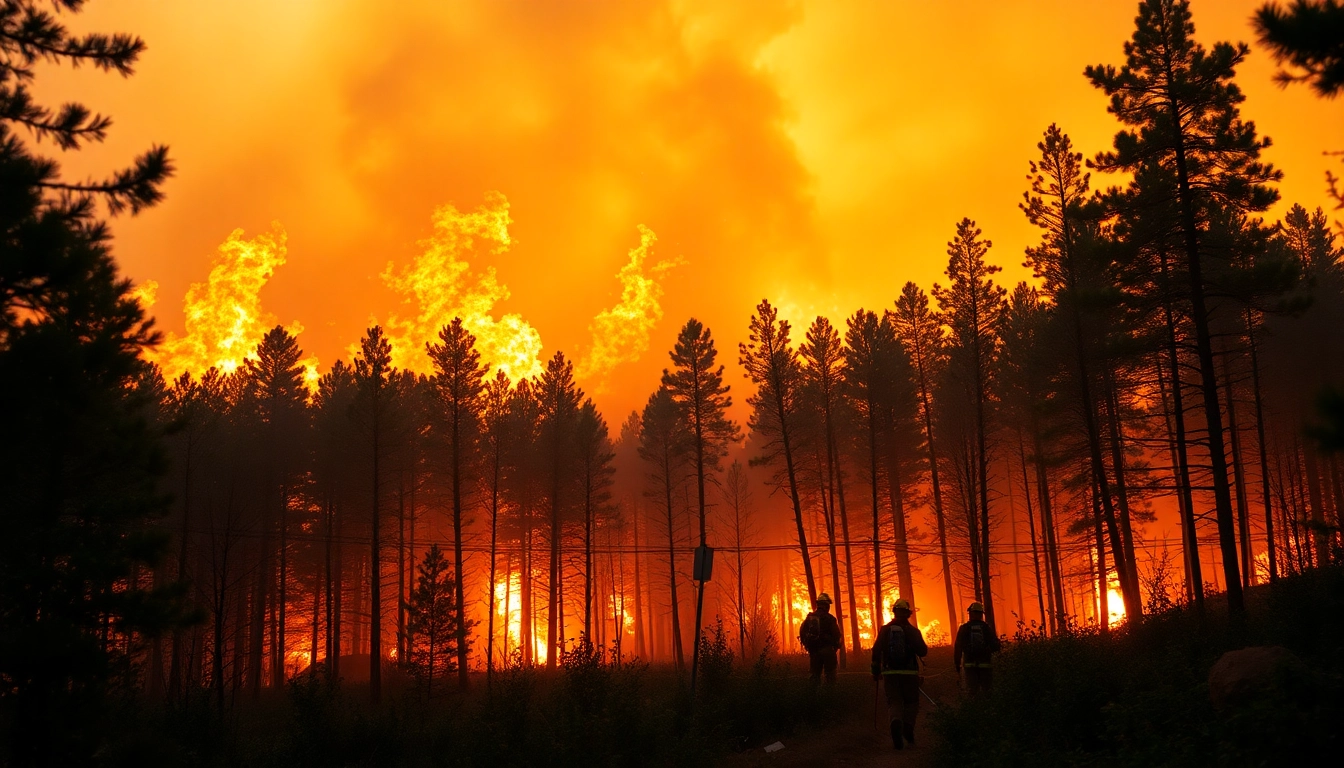Introduction to Wildfire Events
Wildfire events have become an increasingly important subject in the context of global climate change, ecological balance, and community safety. These events, characterized by the uncontrolled spread of fire in natural areas, not only pose risks to ecosystems but also threaten human life and property. Understanding the intricacies of wildfire events is critical for effective preparedness and response strategies. In this comprehensive exploration, we will define wildfire events, delve into their environmental impact, and analyze historical trends to establish a foundation for our discussion. We aim to illuminate all aspects of wildfire events, particularly their causes, implications, and management practices.
Defining Wildfire Events
A wildfire, often referred to as a forest fire, grass fire, or bushfire, is an uncontrolled fire that burns in wildland vegetation. Unlike controlled burns used in forest management, wildfire events can be triggered by various factors and lead to substantial ecological and economic impacts. These fires can vary in size, intensity, and duration, and are classified into different categories based on factors such as the type of fuel consumed, the fire’s behavior, and the area affected. Understanding these classifications is vital for effective wildfire management and response strategies.
The Environmental Impact of Wildfire Events
Wildfire events can have profound effects on the environment. Initially, these fires can be devastating, leading to the destruction of vast tracts of forest, grassland, and other natural habitats. The immediate consequences often include loss of biodiversity, soil erosion, and the release of carbon and other pollutants into the atmosphere. However, wildfires also play a natural role in maintaining ecological balance by recycling nutrients back into the soil and promoting new growth. Certain species of plants, like the lodgepole pine, have adapted to thrive in post-fire environments. Thus, while the short-term effects of wildfires can be harmful, long-term ecological recovery is possible.
Historical Context and Wildfire Trends
Historically, wildfires have been an integral part of many ecosystems around the world. For instance, indigenous practices often included controlled burning as a land management technique. However, in recent decades, the frequency and intensity of wildfire events have surged, correlating with climate changes, forest management practices, and population growth in fire-prone areas. Analyzing historical data can help us identify trends in wildfire activity, understand the increasing severity of these events, and develop improved strategies for prevention and response.
Causes of Wildfire Events
Natural Factors Contributing to Wildfire Events
Natural causes of wildfires include lightning strikes and volcanic eruptions. Lightning is one of the most common natural ignition sources, particularly in regions prone to thunderstorms. Weather conditions such as prolonged droughts, high temperatures, and strong winds can exacerbate these events, creating a perfect environment for fires to ignite and spread rapidly. Additionally, the presence of abundant dry vegetation can serve as fuel, leading to more intense wildfires.
Human-induced Causes of Wildfire Events
Human activities are another major contributor to wildfires. Accidental causes, such as discarded cigarettes, campfires left unattended, and sparks from machinery, can ignite wildfires. Furthermore, arson is a significant concern, where intentional acts lead to devastating fires. Land-use practices, such as logging and land clearing, often increase the risk of wildfires by creating an accumulation of dry debris and altering natural fire regimes.
Climate Change and Its Impact on Wildfire Activity
The connection between climate change and wildfire activity has become increasingly evident. Rising temperatures, changing precipitation patterns, and increased frequency of extreme weather events have all contributed to a heightened risk of wildfires. Areas that once had moderate wildfire activity are now experiencing more frequent and severe events. The warmer temperatures enhance the drying of fuels, making wildfires more likely to ignite and spread. As climate change continues to evolve, the challenge of managing wildfires will require new approaches and innovations to adapt effectively.
Understanding the Impacts of Wildfire Events
Economic Consequences of Wildfire Events
The economic impact of wildfire events can be staggering. They lead to direct costs such as firefighting efforts, property damage, and loss of agricultural productivity. Additionally, the long-term economic consequences can include loss of tourism revenue, increased insurance premiums, and reduced property values in affected areas. The costs associated with recovery and rebuilding after a wildfire can strain local and state budgets, complicating recovery efforts and infrastructure rebuilding.
Social and Health Implications of Wildfire Events
The human toll of wildfire events extends beyond the immediate dangers posed by flames. Wildfires can lead to devastating health impacts, including respiratory issues from smoke inhalation and increased stress and anxiety levels among populations affected by evacuation orders and property loss. The displacement of communities can lead to long-term social ramifications, disrupting lives and eroding social structures. Thus, understanding the multifaceted social and health implications is crucial for effective community planning and rehabilitation.
Ecological Effects and Recovery from Wildfire Events
While wildfires can be destructive, they also play a role in shaping ecosystems. The immediate ecological effects include loss of vegetation and habitat. However, over time, landscapes can recover, often resulting in increased biodiversity as new species thrive in newly available soil and light conditions. Recovery processes can be accelerated through active reforestation and habitat restoration efforts, making it essential for conservation strategies to incorporate the complex dynamics following wildfire events.
Preparedness for Wildfire Events
Creating a Wildfire Action Plan for Communities
Community preparedness is essential for effective wildfire management. Developing a Wildfire Action Plan involves collaboration between local governments, fire departments, and community organizations. Key components of a successful plan include creating defensible spaces around properties, establishing evacuation routes, and providing education and training for residents on fire safety. Engaging communities in the planning process fosters a culture of preparedness and resilience.
Best Practices for Homeowners to Prepare for Wildfire Events
Homeowners can take several proactive measures to prepare for potential wildfire events. These include creating defensible spaces by clearing flammable vegetation within a certain radius of their homes, using fire-resistant building materials, and ensuring easy access for firefighting personnel. Regular maintenance of yards and roofs, alongside community education initiatives, can significantly reduce the risk of fire damage.
Community Engagement and Education on Wildfire Preparedness
Education plays a pivotal role in enhancing community preparedness for wildfire events. Organizations can implement programs that provide information on wildfire risks, safety protocols, and resources available for emergency situations. Engaging local residents through workshops, informational sessions, and community drills can foster a proactive mindset among the public, enabling them to act effectively in the event of a wildfire.
Responding to Wildfire Events
Roles of Firefighting Organizations During Wildfire Events
Firefighting organizations play a vital role in responding to wildfire events. Their responsibilities include fire suppression, protection of life and property, and assistance with evacuations. Coordination between local, state, and federal firefighting agencies is essential for resources to be mobilized effectively. Moreover, inter-agency communication enhances the operational capacity to manage multiple blazes simultaneously.
Technological Innovations in Wildfire Management
The advancement of technology has transformed the approach to wildfire management. Tools such as satellite imagery, drones, and geographic information systems (GIS) facilitate real-time monitoring and mapping of wildfire events. These innovations allow for more effective resource allocation during firefighting efforts and enhance predictive modeling to foresee potential fire spread patterns based on environmental conditions.
Post-Wildfire Recovery and Restoration Efforts
After a wildfire event, recovery and restoration become paramount. Efforts may include rebuilding infrastructure, restoring ecosystems, and providing support for affected individuals and families. Reforestation initiatives and soil restoration programs are essential to rehabilitate landscapes and promote biodiversity recovery. Community support programs can also help residents navigate the challenges of recovery, reinforcing social ties and community resilience.



